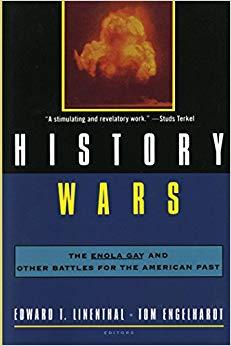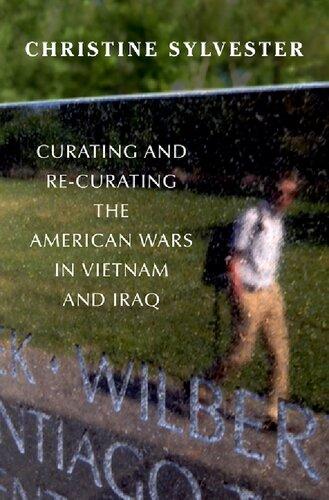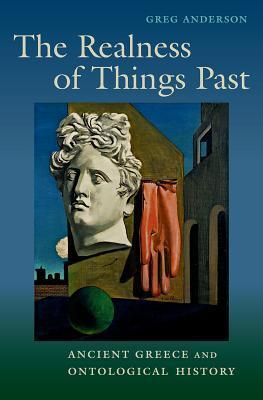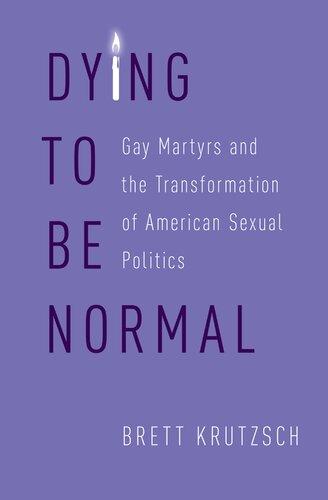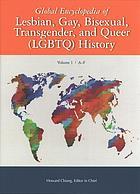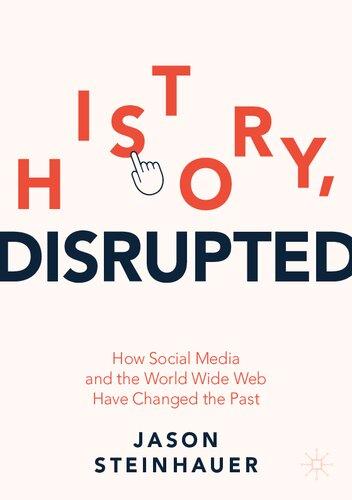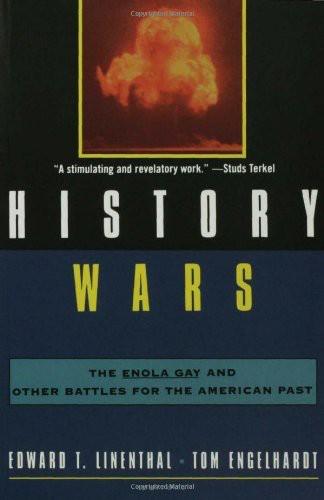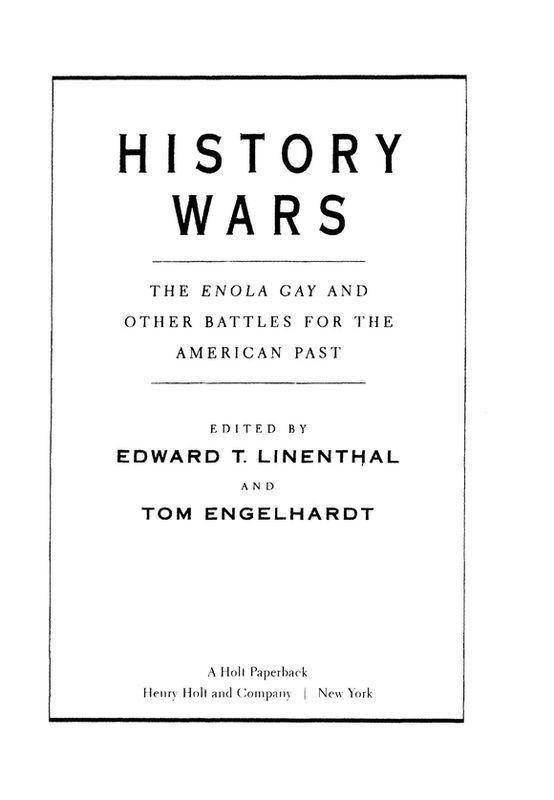INTRODUCTION:HISTORYUNDERSIEGE
TOMENGELHARDTAND EDWARDT.LINENTHAL
OnNovember23,1994,NationalPublicRadio’s Morning Edition informed itslistenersthatoneoftheiconicartifactsofWorldWarIIhadarrivedatthe Smithsonian Institution’s National Air and Space Museum on the Mall in Washington,D.C.“Ataboutaquartertoone,underacloud-coveredmoon,” the reporter began, “four police cars cruised down Independence Avenue, escorting what looked almost like a float in the Macy’s Thanksgiving Day Parade. A flatbed truck carried a huge tube more than fifty feet long, wrapped in what seemed to be white plastic. The tube was the front half of the plane that carried the bomb that killed thousands of Japanese on August 6,1945.”
Here, under wraps, was the imposing fuselage of the Enola Gay, the famedB-29SuperfortressthatdroppedthefirstatomicbombonHiroshima. The aircraft, credited by many with ending a war of unparalleled ferocity, saving countless American lives, and bringing peace to a war-weary world, was now to rest temporarily in the museum that displayed the Wright brothers’firstplane,CharlesLindbergh’socean-spanning Spirit of St. Louis, andtheApollospacecraftthatbroughthumanstothemoon.
Even though it entered the museum in the dead of night, the Enola Gay was shadowed by another story of war’s end. For National Public Radio’s reporter pointed out that the aircraft’s route to the museum was not deserted. One protester sang a song of the hibakusha, those who had survived the atomic bomb the Enola Gay dropped on Hiroshima (a “national peace song in Japan,” the reporter noted). Elsewhere en route, demonstrators from the pacifist Catholic Worker movement unfurled a bannerthatread“Disarm.”
For fifty years, these two stories—of a weapon that brought peace and victory, and of a weapon that brought destruction and fear to the world— resteduneasilyinAmericanconsciousness.Now,theaircraft’sfuselagewas headed toward an exhibit that promised to bring those two narratives together in a single museum space. With the plane as its central icon, that show was to explore the end of a hot war and the beginning of a cold one. As conceived by the Smithsonian’s curators and advisers, the exhibit was to examine the bomb’s creation, the decision to use it against Japanese cities, the Enola Gay’s mission, the ground-level effects of atomic weaponry, the bomb’s role in ending the war, and the new era it inaugurated—as well as the ways in which decades of historical research and debate on these topics hadalteredanddeepenedourunderstandingofthem.
Such an exhibition, however, was not to be. For months, after a draft script of the proposed show was released to the media by the Air Force Association, a military lobbying group, the Smithsonian’s managers and curators as well as the historians on whom they relied were subjected to increasingly angry charges: they had “hijacked history”; they were “antiAmerican”; they were practicing “politically correct” curating; they were projecting the “countercultural values” of the Vietnam era onto America’s last good war. The fierceness of this response eventually doomed the National Air and Space Museum’s planned show amid a remarkable controversy that pitted museum curators and historians against military officials and veterans’ lobbying groups, as well as much of the media and Congress.
The exhibit was abandoned by a humiliated museum administration in January 1995 (to be replaced by a blandly upbeat display of the Enola Gay itself). Meanwhile, there were surprisingly few other memorial festivities celebrating the fiftieth anniversary of World War II’s end—the greatest military victory in U.S. history—even if the final moments of that war were anything but dead in public memory. In fact, it soon became apparent that they still held a rawness startling for events so long past. A oncefamiliar triumphant tale of a victory over Germany and Japan that was to lead to an American Century now seemed to end in disarray on August 6, 1945, in the rubble of Hiroshima. As August 6, 1995, approached, Peter Jennings anchored an ABC television documentary questioning the decision to drop the bomb, while Ted Koppel defended that decision on the same network’s Nightline . Countless talk-radio programs, magazine and news articles,
editorials, books, and book reviews argued over the minutiae of policymaking in 1945 with a passion and vitriol more often associated with fast-breaking news; and increasingly upset World War II veterans struggled to reassert to an oddly resistant nation the victory story they believed was theirdue.
Even with August 1995 past, anger about the Enola Gay exhibit did not die. On September 25, for instance, Robert Dole, Senate Majority Leader, Republican presidential hopeful and World War II veteran, made a pilgrimage to Indianapolis to address the national convention of the American Legion. His right arm and shoulder shattered by an explosive shell in Italy half a century earlier, the seventy-one-year-old Dole stood before the Legionnaires—many of them also aging survivors of his war— onwhathewascallinghisfinal“mission.”
As undoubtedly the last member of that wartime generation to seek the presidency, he had the war on his mind—and not just because he had been reminding the media of his old injury (partly as a rebuke to a young Democratic president long accused of being a “draft dodger”). Facing an audience of sympathetic veterans fifty years after the Japanese signed the instruments of surrender, Senator Dole did not linger on positive memories of a war that had once unified America in righteous victory. Instead, after thebriefestofsurveysof“darkforces…multiplyinginalmosteverycorner of the world” from North Korea to Iraq, he launched a frontal attack on America’s true enemies in a post–Evil Empire world: “the arbitrators of political correctness,” “government and intellectual elites who seem embarrassed by America,” and “educators and professors” engaged in “a shocking campaign … to disparage America” and destroy the “keys” to Americanunity,its“language,history,andvalues.”
He proceeded to attack diversity, multilingualism, affirmative action, and the newly proposed national history standards (whose purpose, he said, was “to denigrate America’s story while sanitizing and glorifying other cultures”). Then, perhaps in search of a little red meat to add to his stump speech diet, he decried the fact that “liberal academic elites control more than our schools,” and began to gnaw on the proposed Enola Gay exhibit, now nine months dead, that had already nourished Pat Buchanan, Newt Gingrich, Rush Limbaugh, and so many other conservative and right-wing politiciansandmediacommentators.
“The Smithsonian created a display to commemorate the anniversary of Hiroshima, the day we effectively won a global war against the forces of evil,” he said indignantly. “The message was that the dropping of the bomb was an act of American violence against Japanese culture. Somehow the JapanesewerepaintednotastheaggressorsbutasthevictimsofWorldWar II. Veterans’ groups like the American Legion that complained were dismissed as special interests who couldn’t be objective. That’s right,” he added after a pregnant pause, “if you love this country so much you’re willing to die for it, maybe you do belong to a ‘special interest,’ but that special interest used to be called the people of the United States of America.”
The fiftieth anniversary of any major event that put large numbers of people in peril naturally tends to establish a protective membrane around the commemorative moment. This accounts, in part, for the outrage that Senator Dole and other veterans expressed over the possibility that America’s preeminent national museum might display historical material complicating or questioning more glorious tales of World War II’s end. At the same time, however, Senator Dole’s comments also reflected familiar themes in recent Republican party politics. After all, appeals to “traditional values” and attacks on the “elitist, liberal” media, the politically correct, and the racially other for supposedly undermining those values (as well as desecrating once-popular American conceptions of the past) have done muchtokeepthevariousfactionsofthepartytogether.
The opening of a history front in the decade-old culture wars, even if only a new twist on an old act for Republicans and right-wingers, has been a genuinely shocking experience for historians committed to examining cherished national narratives. Indeed, the uproar over the Enola Gay show joins a number of other controversies of the 1990s in which historians became unexpected players on a public stage. They found their work debated or attacked, misused and abused, and themselves accused of aiding and abetting the post–Vietnam War fragmentation of an American consensus.
The act of challenging sacred historical narratives is a thankless task at any time, but especially so in periods of great uncertainty. Unquestionably, some of the most incisive scholarship of recent decades has taken on just that task, focusing on groups and experiences previously ignored in American history. But even as historians have seen their influence reach
beyond the academy into various forms of public space—from museums to theme parks, CD-ROM “textbooks” to battlefield memorials—their work has often become contested (and detested) terrain, material for editorialists to condemn, politicians to denounce, and citizens to complain about or protest.
As political players, historians are relatively powerless and unorganized. Facing attacks that may grossly simplify and misrepresent their ideas and intentions, as in the Enola Gay controversy, they have few immediate ways todefend themselves. Whether they fight back orcave intopressure (asthe Smithsonian administration finally did in canceling the original Enola Gay show), they may find themselves in the uncomfortable position of being blamed for creating the very problems whose complexities they set out to explore. As stand-ins for more profound, elusive threats, they present remarkably easy targets and so are likely to take it on the chin—not just from right-wingers and various cultural warriors but from the media in general.
Now that they have been added to the conservatives’ list of domestic enemies, one thing historians can do in their own defense is what they do best anyway. They can consider the various controversies that are troubling us, including those in which they are actors and targets, in light of our past. Theycanbegintomakesomesenseofthewaysinwhichthepastliveswith and within us, the ways remembering—and forgetting—work on us, the ways cultural productions (museum exhibits, living history performances, textbooks) can bring to the surface conflicting readings of our national stories. They can examine what Americans can and cannot bear to look at orconsideratanymoment, andwhy.Thisisthesimple goalofourbook:to let a group of historians take up, explore, and begin to make sense of one highly publicized controversy in America’s ongoing history wars, one which,initsnot-so-brieflife,continuestogeneratefarmoreheatthanlight.
The contributors to this book take as their starting point a draft script for a modest four-room exhibition at the National Air and Space Museum. But they do so in order to see what the ensuing Enola Gay controversy tells us about the state ofournation. The surgeofanger overthe Smithsonian show would have been inconceivable had America’s global role not been in question, its enemies less and less clearly defined, and its past seemingly disintegrating before our eyes while many historical mini-tales—each attractive to some but disturbing or repugnant to others—compete for
attention. In such a situation, reconsideration of the past cannot remain a shelteredormarginalizedundertaking.
The anger also reminds us of the ways in which the cultural fallout from the bomb that destroyed Hiroshima still reaches into our own time, of how we continue to underestimate the destabilizing force of that blast. For the Enola Gay controversy exposed the centrality of the “Good War” to a sacred narrative of American history that has become increasingly distant and imperiled. After all, the history wars in America burst into full force only when it appeared that World War II might be deconstructed and reassembled in possibly irreverent ways at the National Air and Space Museum—andthatthebombingsofHiroshimaandNagasakimightbeused to pry open the “Good War”; indeed to further destabilize a larger sacred mythofthecountry’soriginsanddevelopment.
The United States is not the first country to experience history wars—or to discover the potentially explosive nature of public memory about World War II. Until recently, however, conflict over how that global conflagration shouldberememberedwasafeaturemostconspicuousonthelandscapesof the defeated nations, not that of the victors. In Japan, a public struggle over how the war should be portrayed has been in progress for decades, only intensifying in recent years as growing numbers of citizens, historians, and even politicians challenged the official government version of that war. Similarly, though from a different direction, in Germany in the early 1980s, conservative historians attempting to reframe the accepted version of the war (and of German responsibility for it) became the focal point of an emotional national debate. However, only as the fiftieth anniversary of the war’s end approached did the victors join the vanquished in anguished and angrypubliccontroversy.
Americans like to think that they are capable of looking at their own history soberly, that they have avoided the snares of trivializing, sanitizing, and sanctifying the past into which other nations have fallen. Our own recenthistorywars,however,revealotherwise.Here,then,isananatomyof a thoroughly American controversy, and of an uncertain and unsettled nationattheedgeofthemillennium.
ANATOMYOFACONTROVERSY
EDWARDT.LINENTHAL
When, in the fall of 1993, Martin Harwit, director of the National Air and Space Museum (NASM), asked me to serve on an advisory committee for that museum’s upcoming Enola Gay exhibit, I was excited. After all, for many years I had studied battles over battlefield memorialization, clashes over “sacred ground.” In the late 1980s, I had spent much time with National Park Service personnel as they struggled to transform the Little Bighorn battlefield from a shrine to George A. Custer and the Seventh Cavalry into a historic site where different—often clashing—stories could be told. There, I had first heard curatorial decisions attacked and derided as “politically correct history,” and as a craven caving in to “special interests”; but there, too, I had watched as a complex interpretation of a mythic Americaneventhadsuccessfullysupplantedanenduring“firsttake.”
In the early 1990s, I studied the National Park Service’s preparations for thefiftiethanniversaryofthebeginningofWorldWarIIattheUSS Arizona Memorial in Pearl Harbor. Watching members of the Park Service—and Pearl Harbor survivors—grapple with such a seemingly simple matter as whether a Japanese airman’s uniform should be displayed (in an attempt to give a “human dimension” to the former enemy), I came to a fuller appreciation of the inevitable tension between a commemorative voice—“I was there, I know because I saw and felt what happened”—and a historical one that speaks of complicated motives and of actions and consequences oftenhardlyconsideredatthemomentoftheeventitself.
By the time Martin Harwit called me, I had published a book on the problems of memorializing American battlefields, from Lexington and ConcordtoPearlHarbor,andhadformorethanayearbeenobservingfrom
within the volatile creation of the United States Holocaust Memorial Museum. In addition, as a historian I was aware of how uneasily the atomic bombing of Hiroshima rested in the American consciousness. Nonetheless, nothing in my experience with memorial exhibits prepared me for what happened when the National Air and Space Museum tried to mount its Enola Gay exhibit to mark the fiftieth anniversary of the end of World War II.
I certainly imagined that such a show would raise difficulties for the museum—problems between the commemorative and historical voices, between a reverently held story and its later reappraisal. But I expected, as had happened elsewhere, that the museum would overcome them and that a historicallysignificant Enola Gay exhibit would open in 1995. In fact, I felt remarkably sanguine about the problems or issues that might arise, and the record of the advice my colleagues on the committee and I offered the museum during its early script preparations indicates how little any of us foresaw what lay in the museum’s path. So the following reconstruction of the ugly controversy that doomed the exhibition is meant not just as a record of the failures and errors of others, but also of what I proved incapableofimaginingaseventsbegantounfold.
There is probably no better place to start that reconstruction than with a simple fact that was largely ignored while the controversy was under way. Although uneasiness about the Enola Gay and its mission would often be calledaproductofadisaffectedVietnamgeneration,left-winghistorians,or the politically correct, its roots are half a century old. In the spring and summer of 1945, for example, the American press engaged in lively debate over alternatives to unconditional Japanese surrender. There was vigorous disagreement among Manhattan Project scientists who made the atomic bomb about the wisdom of the decision to use it, and after the war’s end, there was strong criticism of its use from many prominent Protestant and Catholicspokespeople.
Influential conservative voices also criticized the decision. In 1948, Henry Luce, the founder of Time, wrote, “If instead of our doctrine of ‘unconditional surrender,’ we had all along made our conditions clear, I have little doubt that the war with Japan would have ended no later than it did—without the bomb explosion that so jarred the Christian conscience.” Similar criticism was voiced by Hanson Baldwin, military affairs correspondent for the New York Times, David Lawrence, editor of United
States News, and various conservative journals. For example, writing in William F. Buckley’s National Review in May 1958, Harry Elmer Barnes argued that “the tens of thousands of Japanese who were roasted at Hiroshima and Nagasaki were sacrificed not to end the war or save American and Japanese lives but to strengthen American diplomacy vis-avis Russia.” Within a few years, note media critics Uday Mohan and Sanho Tree, “this iconoclastic position taken in the conservative National Review would be labeled as ‘left-wing revisionism’ and would remain thus to this day.”1
Artifact: The Uncomfortable Presence of the EnolaGay
Enduring uneasiness with the use of atomic weapons was also expressed in an enduring lack of enthusiasm for displaying the Enola Gay. After its mission, the plane returned to Tinian. On November 6, 1945, it was flown to Roswell Air Force Base, New Mexico. “After some modifications,” a National Air and Space Museum report notes, it was flown back to the Pacific for Operation Crossroads, a test in the Marshall Islands “to determine the effects of atomic weapons on naval ships.” However, the Enola Gay did not take part, because of engine problems. On July 2, 1946, itwasstoredatDavisMonthanArmyAirForceBase,Arizona. 2
Several months earlier, on March 5, 1946, New Mexico senator Carl Hatch had drafted a bill to house the Enola Gay in an “Atomic Bomb National Monument” at Alamogordo, New Mexico, under the stewardship oftheNationalParkService.Thesite,SecretaryoftheInteriorHaroldIckes wroteRobertPatterson,secretaryofwar,wasappropriateforthe Enola Gay because of its “links with Hiroshima” and because it “vividly demonstrates the ease with which atomic power could again be devoted to the destructiveness of war.” Hillary A. Tolson, the acting director of the National Park Service, sought to assuage critics by stating that the use of atomic weapons would be “interpreted impartially without praise or blame
… . Doubtless,” he added, “the airplane would be a grim reminder of the destructive potentialities of this new power, but we hope to emphasize in contrast to it the medical and other constructive gains which atomic energy makes possible.” The hope, said Tolson—clearly interested in portraying the “sunny side” of atomic energy—was that atomic power would in the
future be used only for “peaceful ends.” While the War Department soon agreed to transfer the Enola Gay to the National Park Service’s care, Hatch’s plan was never carried out, partly because the Atomic Energy Commissionobjectedtoit.3
On July 3, 1949, Colonel Paul W. Tibbets, Jr., the pilot for the Hiroshima mission, flew the Enola Gay to Park Ridge, Illinois—a facility that would eventually become O’Hare International Airport—where it was put under the jurisdiction of the Smithsonian’s National Air Museum (the word Space would be added to its name in 1966). At the acceptance ceremony, a Smithsonian representative, delivering a speech written by head curator PaulGarber,called attention totheplane’s“majesty.”Whentheaircraft had “laid its egg, the Atomic Age was born.” It would now rest in the nation’s “ValhallaoftheAir.”4
On December 2, 1953, the plane moved to Andrews Air Force Base in Maryland, where it sat outside for seven years. In 1956, a journalist lamented that vandals had damaged the aircraft, and that “today, the once bright aluminum exterior is dull. The propellers are rusting, windows have been broken out, instruments smashed and the control surface fabric torn.” Between August 10, 1960, and July 21, 1961, the Enola Gay was disassembledanditscomponentsmovedtothePaulE.GarberPreservation, Restoration and Storage Facility for the Smithsonian’s National Air MuseuminSuitland,Maryland.
The Enola Gay was not entirely forgotten, however. Beginning in 1961, visitors could make appointments to see the plane’s components, and in 1971, these became part of the Garber facility’s daily tours. Still, a Washington Post reporter noted in 1979 that compared with the proud display of so many aircraft at the National Air and Space Museum on the Washington Mall, the Enola Gay sat “disassembled and virtually forgotten … in a suburban Maryland warehouse,” for all practical purposes, hidden from sight. “Out of sight, out of mind” suited some members of the museum’s staff, who in 1960 thought the plane would be “out of place alongside objects intended to engender pride.” The matter seemed moot when budgetary concerns forced the Smithsonian to drastically scale back the size of the museum’s new building—which would finally open on July 1,1976—adecisionthat“effectivelyexcludedthe‘EnolaGay.’”5
Uneasiness with any future relocation of the Enola Gay was evident in congressional hearings on the Smithsonian in 1970. Senator Barry
Goldwater of Arizona, an air force enthusiast who had been an Army Air ForcespilotduringWorldWarII,statedthat“whatweareinterested inhere [for the museum] is the truly historic aircraft. I wouldn’t consider the one that dropped the bomb on Japan as belonging to that category.” Congressman Frank Thompson agreed: “I don’t think we should be proud of [the use of atomic weapons] as a nation. At least it would offend me to see it exhibited in the museum.” The museum’s acting director, Frank Taylor, defended the possible display of the Enola Gay only by claiming it wouldbeofinterestto“studentsinthefuture.”6
During the early 1980s, a few B-29 veterans urged the museum to restore and display the Enola Gay. Others believed that the only solution was to move the aircraft to a different museum. In 1981, Ohio state auditor Thomas A. Ferguson led a move to bring the Enola Gay to the Air Force Museum in Dayton, Ohio. The Smithsonian, he thought, had buried an essential American artifact. “To me, storing the Enola Gay for thirty-four years is akin to mothballing the Statue of Liberty or the first space capsule thatlandedonthemoon.”7
Sensitive to such criticism, the Smithsonian finally did begin restoration work on the Enola Gay on December 5, 1984. “Components were returned to their original colors and appearance, decals were replaced and the instrument panels and throttle area were restored … . Plans are to retain only those markings that were on the airplane in August 1945.” Although restoration only exacerbated the museum’s ambivalence about the plane’s eventual display, there would be a new drive to exhibit it in some fashion when Martin Harwit, a distinguished Cornell astrophysicist, became the museum’s new director in 1987. His predecessor, Walter Boyne, a retired career air force officer, had opposed plans to display the Enola Gay because, he felt, the public did not have an “adequate understanding with which to view it.” Even before accepting the job, however, Harwit had indicated to Smithsonian secretary Robert McCormick Adams that he was infavorofdisplayingtheplane.8
Born in Czechoslovakia, Harwit brought with him vivid personal memoriesofthehorrorsofWorldWarII.“Thereisjustnoquestionthatthis had a very big impact on the family. My father was counting up recently howmanypeoplehaddiedinconcentrationcamps.Ithinkonhissideofthe family alone there were twelve.” His father—dismissed from the German university in Prague in 1938—took the family to Istanbul, where he was a
Another random document with no related content on Scribd:
The Project Gutenberg eBook of Seuratkaamme häntä!
This ebook is for the use of anyone anywhere in the United States and most other parts of the world at no cost and with almost no restrictions whatsoever. You may copy it, give it away or re-use it under the terms of the Project Gutenberg License included with this ebook or online at www.gutenberg.org. If you are not located in the United States, you will have to check the laws of the country where you are located before using this eBook.
Title: Seuratkaamme häntä!
Author: Henryk Sienkiewicz
Translator: M. L.
Release date: February 2, 2024 [eBook #72858]
Language: Finnish
Original publication: Pori: Otto Andersin, 1902
Credits: Tapio Riikonen
*** START OF THE PROJECT GUTENBERG EBOOK SEURATKAAMME HÄNTÄ! ***
SEURATKAAMME HÄNTÄ!
Kertomus
Kirj.
HENRYK SIENKIEWICZ
Suomentanut
M. L.
Porissa, Gust. Roneliuksen kirjakaupan kustannuksella, 1902.
SISÄLLYS:
Jouluvieraita.
Mies ja vaimo.
Joulutervehdys sydänmaasta. Koti!
Koivun rungossa 1860—1890.
Toteutuvia ennustuksia.
Hyvällä tuulella.
Ison sisaren häät. "Syntistä elämää".
Kirjojen jouluyö. Fantasia.
Henryk Sienkiewicz.
Henryk Sienkiewicz kuuluu vanhaan liettualaiseen aatelissukuun ja on syntynyt 1846. Hän opiskeli Warsowan yliopistossa. Kahdenkymmenen kolmen vuoden ikäisenä julkaisi hän ensimäisen romaaninsa, Turhaan, jossa hän kuvailee oman aikakautensa elämää. Mutta vasta v. 1878, matkansa jälkeen Amerikassa ja
useissa Europan maissa, alkoi hän saada pysyväistä mainetta ensi luokan kirjailijana. Siltä ajalta ovat m.m. teokset: Hiilipiirroksia (suomeksi), Janko musikantti, Leipätaistelun aikana (suomeksi), Bartek voittaja y.m., jotka kaikki ovat täynnä lyriikkaa, huumoria, katkeruutta ja syvää surua kärsivien tähden. Mestarin kädellä maalailee hän kurjien valtiollisten ja yhteiskunnallisten olosuhteiden aikaan saamat kurjuudet.
Verrattomissa historiallisissa romaaneissaan: Tulella ja miekalla, Vedenpaisumus, Herra Wolodyjowskija Ristiritarit kuvailee kirjailija, joka on lämmin onnettoman isänmaansa ystävä, asianymmärryksellä ja tarkkuudella Puolan sankaritaisteluja Saksan ritaristoa, kasakoita, turkkilaisia ja ruotsalaisia vastaan.
Sienkiewiczin teokset nykyisestä Puolasta ovat: Ilman dogmeja (1890) ja Polanieckin perhe (1894). Edellisessä hän ruoskii uskottomuutta ja henkistä laiskuutta, jälkimmäisessä esitetään yhteiskunnan parannuskeinoksi kristillisyys ja siitä johtunut tarkka velvollisuuden tunto.
Nerokkain hänen kirjoistaan on epäilemättä Quo vadis? (1895), joka on suomeksikin ilmestynyt. Siinä käsitellään keisari Neeron aikoja, Rooman paloa ja kristittyin kauheata vainoa sekä näytetään Kristus siksi johtotähdeksi, jonka avulla maailman arvoitus saatetaan ratkaista.
Seuratkaamme häntä! on suurenmoisempi sisällölleen kuin Quo vadis. Nopeasti toisiansa seuraavissa kuvissa liukuvat siinä ohitsemme ihmiset ja tapahtumat Roomassa, Aleksandriassa ja Jerusalemissa, noissa kolmessa antiikisen sivistyksen Centrumeissa. Siinä saamme myös tarkastella uskonnollisen kehityksen kolmea astetta: pakanuutta, milloin rakastettavana ja hienona, milloin taasen
raakana ja julmana: juutalaisuuden ankaria lakeja; kristillisyyden oppia rakkaudesta ja anteeksi-antamisesta.
Päähenkilöt teoksessa ovat: Cinna, Antea ja Pontius Pilatus. Ne ovat psykologisia muunnoksia Quo Vadiksen Viniciuksesta, Lygiasta ja Petroniuksesta. Mutta kuolevan pakanamailman sijasta kohtaa meitä täällä Hekaten kummituskasvot, apostolien Pietarin ja Paavalin asemesta itse Kristus, Neeron cirkuksen sijasta Golgatha. Esillä ovat myös kreikkalaiset filosofit ja juutalaisten korkea raati.
SEURATKAAMME HÄNTÄ!
I.
Roomalainen patrici Cajus Septimus Cinna oli viettänyt nuoruutensa legionissa ja siellä kokenut sotilaselämän vaikeat vaivat.
Sitte hän palasi kotiin Roomaan, nauttimaan sotilaskunniastaan sekä loistosta ja mukavuudesta, jonka voi hankkia melkoisella omaisuudella.
Heti hän syöksyi huvien pyörteeseen ja nautti kyllästymiseen saakka kaikesta, mitä tuolla ihmeellisellä maailmankaupungilla oli suinkin tarjottavana. Yönsä vietti hän hurjissa juomingeissa muhkeissa huviloissaan, jotka sijaitsivat etukaupungeissa, päivänsä ruumiinharjoituksissa lanistain [henkilöitä, jotka kouluttivat gladiatoreja arenaa varten. Suom.] luona, keskusteluissa reetorien kanssa, termeissä, missä kaikenlaisia asioita keskusteltiin, sekä kaupungin juoruja kuunneltiin ja levitettiin, tai myöskin cirkuksessa ja gladiatorein arenalla, tracilaisten velhonaisten ja Arkipelagin saarilta kotoisin olevien lumoavien tanssijattarien parissa.
Hän oli sukua äidin puolelta kuuluisalle Lukullukselle ja oli tältä perinyt himon kitalaen nautintoihin. Hänenkin pöytänsä notkuivat nimittäin kreikkalaisten viinien, Neapelin ostronien sekä Vähästä-
Aasiasta tuotujen ja Numidian hunajaan hillottujen syötettyjen heinäsirkkain painosta; yleensä kaikki harvinaiset herkut, mitä Rooma vain suinkin saattoi tarjota, olipa ne sitte joko kaloja Punaisesta merestä taikka valkeita peltokanoja Dnjeprin rantamilta, eivät suinkaan saaneet puuttua Cinnan aterioista.
Mutta tästä ajallisesta hyvyydestä nautti hän, ei kuten ahmatti sotilas, vaan niinkuin läpeensä hienostunut patrici ainakin.
Hän oli koettanut uskotella itselleen — ja oli kenties siinä onnistunutkin — että hän muka intohimoisesti rakastaa taiteen tuotteita. Hän oli hurmaantunut Korinton raunioista kaivettuihin kuvapatsaisiin, attikalaisiin lamppuihin, etruskilaisiin vaaseihin, savitavaroihin, jotka olivat kotoisin idän usmaisista maista, roomalaisiin mosaikkiteoksiin, Eufratin kankaisiin ja Arabian lemuaineisiin, lyhyesti sanoen kaikellaisiin niihin ylellisyystavaroihin, jotka tavallisesti täyttävät ylimyksen tyhjän elämän.
Semmoisista saattoi⁻ Cinna asiantuntijana ja harrastajana keskustella hampaattomien ukkojen kanssa, jotka pöytään käydessänsä seppelöivät paljaat päälakensa ruusuilla ja aterian jälkeen pureksivat heliotroopin lehtiä saadakseen hengityksensä hyvänhajuiseksi. Hän kykeni arvostamaan kauneutta niin hyvin Ciceron ajatuksissa kuin Horatiuksen ja Ovidiuksen värsyriveissäkin. Koska hän oli opiskellut erään ateenalaisen reetorin johdolla, puhui hän virheettömästi kreikkaa, taisi ulkoa kokonaisia lauluja Iliadista ja saneli pikari kädessä Anakreonin säkeistöjä siksi, kunnes juopuneena vaipui syvään uneen. Kiitos opettajansa ynnä toisten reetorein, omasi hän myöskin riittävästi suuret tiedot filosofiassa, käsittääkseen niitä rakennustaiteellisia muistomerkkejä, joita muinoin Hellaassa ja siirtomaissa pystytettiin ihmisellisen neron kunniaksi. Myöskin hän
tiesi, ettei näistä rakennuksista enää ollut muuta jälellä kuin korkeat rauniokasat.
Hän oli persoonallisesti tuttava useampain kanssa stoalaisten joukosta, vaikkakin hän oikeastaan oli vihamielisellä kannalla heitä kohtaan sekä piti heitä valtiollisena puolueena ja askeetteina, jotka elämän nautintoja halveksivat. Skeptikot olivat usein hänen pöytävierainansa ja ehtivät ruokalajien lomassa repiä alas monta filosofista järjestelmää, sekä täysinäisiä viinipikareita kohottaessaan selittivät, että huvi on pelkkää turhamaisuutta eikä totuus voi koskaan tulla todellisuudeksi eikä viisaalla ole muuta päämäärää kuin lepo ja tyyneys.
Tarkkaavaisena kuunteli Cinna heidän keskusteluansa, mutta ei antanut sille erityistä arvoa. Hän ei omaksunut kumpaakaan ajatuskantaa, ei myöskään halunnut saada omaa mielipidettä. Hänen käsityksensä mukaan oli Cato personoitu ääretöin voima ynnä lisäksi ääretöin määrä tyhmyyttä.
Hänen mielestään oli elämä kuin meri, jossa alinomaa vaihtelevat tuulet puhaltelevat. Viisaus on siinä, että osaa kulloinkin laittaa purjeet niin, että alus aina kulkee eteenpäin.
Mutta hän pani myös paljon arvoa leveihin hartioihinsa, hyvään vatsaansa ja hyvin muodostuneeseen päähänsä kotkaprofileineen ja tarmokkaine suineen. Hän oli myöskin vakuutettu, että hän täten varustettuna saattoi joka tapauksessa viettää hauskaa elämää.
Kuulumatta skeptilliseen kouluun oli hän kuitenkin elämässään skeptillinen ja samalla kertaa cyreneläinen, vaikka hän hyvin tiesi, että huvi ei onnea tee. Hän piti itseänsä epikurolaisena, mutta ei tuntenut Epikuron opin sisällystä.
Yleensä oli hänestä filosofia älyn harjoitusta, yhtä hyödyllistä kuin voimistelu lanistain luona.
Jos keskustelu alkoi tuntua väsyttävältä, meni hän cirkukseen saadakseen nähdä veren virtaavan.
Hän uskoi yhtä vähän jumaliin kuin hyveisiin, totuuteen tai onneen; ainoastaan noituuteen hän luotti. Hän oli taikauskoinen, ja tuo itämaisten uskontojen salaperäisyys miellytti häntä.
Orjilleen oli hän hyvä, ellei vaan ikävystyminen kiihoittanut häntä julmuuteen.
Hänen käsityksensä mukaan oli elämä kuten amfora [poltetusta savesta tehty ruukunmuotoinen viiniastia, noin 26 litran vetoinen. Suom.], jota kalliimmalla viinillä sen täytät, sitä suurempi on sen arvo. Myöskin hän koetti täyttää elämänsä paraalla, mitä maailma voi antaa.
Hän ei rakastanut ketään, mutta löytyi paljon, josta hän piti, kuten esim. hänen oma kaunis päänsä muhkeine aivokoppineen, ja somat patricilaiset jalkansa.
Iloisen elämänsä ensi vuosina oli hän huvitellut hämmästyttämällä Roomaa ylellisillä oikuillaan; siinä oli hän osittain onnistunutkin.
Mutta sittemmin oli hän kyllästynyt myöskin siihen huviin.
II.
Cinna oli joutunut häviöön.
Hänen omaisuutensa oli mennyt velkojille; hänelle itsellensä ei ollut jäänyt muuta jälelle, kun väsymys, semmoinen, jota tuntee raskaan työn jälkeen, sekä kyllästyminen — ynnä vielä jotakin, mitä hän ei ollut ennen kokenut: epämääräinen, mutta syvä levottomuuden tunne.
Sitä ennen oli hän täyteen mittaan nauttinut rikkaudestaan ja rakkaudesta — siinä merkityksessä kun sen käsitti silloinen maailma — nauttinut kaikellaisesta uhkeudesta ja sotilaskunniastaan.
Hän oli koetellut vaaroja, enemmän tai vähemmän lähestynyt ihmisellisen ajatuksen rajoja sekä työskennellyt runouden ja kaunotaiteiden kanssa.
Siksipä hän saattoikin uskoa saaneensa elämältä kaikki, mitä se suinkin voi antaa.
Ja nyt oli hänellä hämärä aavistus, että oli jotain laimiinlyönyt ja että tämä jotain oli suuresta merkityksestä. Mutta hän ei voinut saada selkoa, mitä se olisi ja mietti sentähden ankarasti sitä.
Usein hän koetti näitä ajatuksiansa poistaa, yritti itsestään ravistaa tätä levottomuutta, joka hänet oli vallannut, sekä uskotteli itseänsä, ettei muka löydy mitään enempää, ei voi löytyä mitään enempää elämässä. Kuitenkaan ei levottomuus haihtunut, vaan päinvastoin kasvoi, kasvoi siihen määrään, että hän rupesi huolehtimaan, ei ainoastaan itsensä vuoksi, vaan koko Rooman tähden.
Skeptikoita hän samalla kertaa sekä kadehti että piti narreina, syystä kun he väittivät, että tyhjyyden voi täyttää olemattomuudella.
Cinnassa näytti olevan kaksi ihmistä: eräs, joka ihmetteli levottomuutta ja toinen, joka vastoin tahtoaankin huomasi sen täydellisesti oikeutetuksi.
Omaisuutensa menettämisen jälestä nimitettiin hänet Aleksandrian maaherraksi — kiitos siitä mahtavain sukulaisten vaikutusvallalle — ja hän matkusti uuteen virkapaikkaansa iloisessa toivossa, että voisi tuossa rikkaassa maailmankulmassa vielä parantaa taloudellisen asemansa.
Mutta Brindisissä astui levottomuuskin mukana laivaan ja teki uskollisesti seuraa koko matkan.
Hän toivoi, että uusi virka, uudet ihmiset, uusi maailma ja uudet vaikutukset piankin karkottaisivat tuon painajaisen.
Mutta siinä hän pettyi.
Kuukausi kului nimittäin, toinenkin, ja, kuten se siemenvilja, jota Demetrius toi Italiasta, kasvaa rehottaa uhkeammin suistomaan viljavassa maanlaadussa, loi Cinnan levottomuuskin hänen sieluunsa
yhä synkemmän varjon niinkuin tuuheaksi seetripuuksi ylennyt pensas.
Hän koetti sitä haihduttaa viettämällä samanlaista elintapaa kuin ennen Roomassa.
Aleksandria oli muhkea kaupunki, jossa vilisi vaaleanvereviä, hieno-ihoisia kreikattaria, joiden jäsenet olivat Egyptin auringosta saaneet merenkullan läpihohtoisen värin.
Niiden sylissä etsi Cinna unhotusta.
Huomattuaan senkin turhaksi joutui hän itsemurhan-ajatusten kiusattavaksi.
Itsemurhalla olivat monet hänen ystävistänsä vapauttaneet itsensä elämän kärsimyksistä, ja tehneet sen paljoa vähäpätöisemmistä syistä: jotkut vain sentähden, että heillä oli ollut ikävä taikka tunteneet elämänsä tyhjäksi; toiset taasen syystä, kun olivat menettäneet halunsa maallisiin nautintoihin. Itsemurhaanhan tarvittiin muuten vain ainoastaan, että joku orja piteli silmänräpäyksen ajan miekkaa voimakkaalla kädellä.
Itsemurhan-ajatus siis valtasi Cinnan, ja olikin hän juuri toteuttamaisillaan sen, kun muuan ihmeellinen uni tuli esteeksi.
Hän uneksi nimittäin olevansa purjehtimassa erään joen yli. Äkkiä hän huomasi toisella rannalla levottomuutensa, väsymyksestä riutuneen orjan haahmossa. Tämä tervehti häntä seuraavin sanoin:
"Minä tulin edeltä ollakseni vastassasi."
Cinna peljästyi ensi kerran elämässään.
Hän käsitti, että ellei hän ilman levottomuutta saata ajatella elämää haudan toisella puolen, niin levottomuus varmaan sinnekin häntä seuraa.
Tarttuen viimeiseen keinoon, päätti hän sentähden tavata noita viisaita miehiä Serapeumissa, heiltä saadakseen arvoitukseensa ratkaisun.
Mutta eivät nämäkään filosofit kyenneet tätä arvoitusta ratkaisemaan. Sen sijaan, ikäänkuin selityksen korvaukseksi, antoivat he Cinnalle arvonimen viisas, joka nimitys tavattiin lahjoittaa korkeasukuisille ja ylhäisessä asemassa oleville roomalaisille.
Kehno lohdutus. Arvonimi viisas annettuna miehelle, joka ei kyennyt saamaan selvitystä siinä, mitä hän eniten mietiskeli, tuntui suorastaan ironialta.
Mutta hän ajatteli, ettei Serapeum kai yhdellä kertaa ilmoittanut kaikkea tietoansa, ja saattoi siten pitää yllä heikkoa toivoa.
Etevin Aleksandrian filosofeista oli tuo jalo ateenalainen Timon, arvossa pidetty Rooman kansalainen. Jo useita vuosia oli hän asunut Aleksandriassa, jonne oli tullut tutkiakseen Egyptin salaisia tieteitä. Sanottiin, ettei kirjastossa löytynyt sitä pergamenttirullaa eikä paperikääröä, jota hän ei ollut läpilukenut, ja että hän muka omasi koko ihmisellisen viisauden.
Lisäksi oli hän lempeä ja tarkkanäköinen.
Ahdas-älyisten selittäjäin ja sanansaivartelijain parvesta eroitti Cinna hänet heti, kiintyi häneen ja teki hänen tuttavuuttansa sekä
tuli lopulta hänen uskotuksi ystäväkseen.
Nuori roomalainen kuunteli hämmästyksellä tuon vanhuksen dialektista taitoa ja kaunopuheisuutta, kun hän pohti ihmisyyden ja maailmankaikkeuden korkeata merkitystä.
Mika erittäinkin Cinnaa ihmetytti oli se, että Timonin syvämietteisessä puheessa oli kaihomielisyyden leima.
Myöhemmin, kun heidän ystävyytensä oli tullut sydämmellisemmäksi, tunsi hän suurta halua kysyä vanhalta filosofilta syytä tuohon surumielisyyteen sekä sitte vuorostansa avata sielunsa hänelle.
Ei kauan viipynytkään, ennenkuin tilaisuus siihen ilmestyikin.
III.
Eräänä iltana, vilkkaan keskustelun jälestä sielun kulkuteistä ylimaailmallisissa tienoissa, olivat Timon ja Cinna jääneet kahden kesken terassille, josta oli laaja näköala merelle.
Nuori roomalainen tarttui vanhuksen käteen ja tunnusti hänelle elämänsä suurimman tuskan sekä kertoi, minkätähden hän oli etsinyt Serapeumin oppineita ja filosofeja.
"Timon", lopetti hän, "siitä oli minulle kumminkin se hyöty, että opin sinut tuntemaan, ja nyt tiedän, että ellet sinäkään voi elämäni arvoitusta ratkaista, niin ei kukaan muukaan kykene sitä tekemään."
Timon silmäsi pitkän aikaa vedenpintaa, joka levittäytyi heidän eteensä ja kuvasteli kalvossaan puolikuun sirppiä, sekä lausui vihdoin:
"Cinna, oletko nähnyt lintujen parvia, kun ne talvisin muuttavat tänne pohjolan pimeydestä? Tiedätkö, mitä ne etsivät Egyptin maasta?"
"Kyllä. — Lämpöä ja valoa."
"Myöskin sielu etsii lämpöä, joka ei ole mitään muuta kuin rakkautta, ja valoa, joka on samaa kuin totuus. Mutta lintu tietää, mihin sen on kulkunsa suunnattava saavuttaakseen onnensa; sielu sitävastoin harhailee ympärinsä tietämättömyydessä, surussa ja levottomuudessa."
"Minkätähden, jalo Timon, ei hän kykene löytämään tietänsä?"
"Muinoin antoi usko jumaliin meille rauhaa. Nyt on tämä usko sammunut, kuten lampun liekki. Sitte luultiin, että filosofia totuuden auringon tavalla valaisisi sielun. Kuten tiedät, istuvat nykyään, niinhyvin Roomassa kuin Ateenassa ja täälläkin, filosofian raunioilla skeptikot, jotka luulottelevat antavansa rauhaa, mutta tuottavatkin vain sekasortoa. Sillä kääntyä poispäin valosta ja lämmöstä, on samaa kuin jättää sielu pimeyteen, ja pimeys on levottomuutta. Koettakaamme siis, kädet eteenpäin ojennettuina, hapuilla uloskäytävää…"
"Sinäkään et siis ole sitä löytänyt?"
"Minä olen etsinyt sitä, mutta en ole löytänyt. Sinä olet sitä etsinyt huvien pyörteistä, minä sitä vastoin ajattelemisesta. Ja molempia meitä ympäröi sama pimeys. Et sinä yksinäsi kärsi, vaan se on maailmankaikkeuden sielu, joka sinussa kärsii… Onko siitä pitkä, kun olet lakannut jumaliin uskomasta?"
"Roomassa niitä palvellaan virallisesti, vieläpä on sinne tuotu uusia jumaliakin, jotka juontavat alkunsa Aasiasta ja Egyptistä; mutta kenties ei kukaan muu niihin oikeen todenteolla usko kun vihannesten kauppias, joka aamuisin tulee maalta kaupunkiin."
"Ja ainoastaan hänellä on rauha."
"Samalla tapaa kuin niillä, jotka täällä kumartuvat maahan kissojen edessä."
"Ja myöskin niillä, jotka noiden kylläisten eläinten lailla eivät halua muuta kun saada rauhassa nukkua, sitte kuu ensin ovat ahtaneet itsensä täyteläisiksi."
"Asianlaidan näin ollessa, onko sitte eläminen laisinkaan vaivan arvoista?"
"Tiedämmekö me, mitä kuolemalla on varastossa meidän varallemme?"
"No, mitä eroitusta on nyt sinun ja skeptikkojen välillä?"
"Skeptikot tottuvat pimeyteen tai ainakin teeskentelevät olevansa siihen tottuneita, minä kärsin siitä."
"Ja etkö näe vapahdusta?"
Timon oli vaiti hetkisen, lausui sitte hitaasti, epäröiden: "Minä odotan vapahdusta."
"Mistäpäin?"
"Sitä en tiedä."
Hän nojasi päätänsä kasvoihinsa ja jatkoi — kenties ympärillä vallitsevan hiljaisuuden ja rauhan vaikuttamana — matalalla äänellä:
"Ihmeellistä! Toisinaan tuntuu minusta, että meidän ei pitäisi tuntea ollenkaan levottomuutta siinä tapauksessa, jos maailma ei sisältäisi enempää kuin sen, mitä me jo tunnemme, ja siinä tapauksessa, jos ei meistä tulisi enempää kuin me nyt olemme… Siis
tuon minä juuri sairauden lähteestä parantumisen toivon… Usko Olympiaan ja filosofiaan on kuollut. Mutta kenties löytyy terveys jossakin uudessa totuudessa, jota minä en tunne…"
Vastoin kaikkea odotusta, tuotti tämä keskustelu Cinnalle todellista lievennystä. Kun hän sai kuulla, ettei hän yksin kärsinyt tästä sairaudesta, vaan koko maailma hänen kanssansa, tunsi hän samanlaista tunnetta kuin se ihminen, jonka seljästä nostetaan raskas kuorma ja jaetaan se tuhansille hartioille.
IV.
Päivä päivältä tuli Cinnan ja vanhan kreikkalaisen ystävyys yhä sydämmellisemmäksi. Usein he kävivät toistensa luona, jakoivat leipänsä ja vaihtoivat ajatuksiansa.
Vaikka Cinna olikin paljo elämästä kokenut ja sitäpaitsi sairasti liikanautinnon aiheuttamaa väsymystä, oli hän kuitenkin siksi nuori, että maailmalla vielä varastossaan löytyi jotain hänelle tähän asti tuntematointa hurmausta.
Tämän hurmauksen löysi hän Timonin ainoassa lapsessa, Anteassa.
Se arvo, jota Antea Aleksandriassa nautti, ei ollut suinkaan vähempi sitä suosiota, jota hänen isälleen osotettiin; jalot roomalaiset, jotka seurustelivat Timonin talossa, häntä kunnioittivat, samoin kreikkalaisetkin ja Serapeumin filosofit sekä koko kansa.
Timon ei pitänyt häntä gyneceumiin [naisten huone. Muinaiskreikkalaisen talon sisin osa, jossa naiset asuivat. Suom.] suljettuna, kuten yleensä oli tapa naisten suhteen; päinvastoin koetti hän häntä tutustuttaa kaikkeen siihen, mitä itsekin tiesi.
Tuskin oli Antea lapsuuden ijän taaksensa jättänyt, kun isä oli antanut hänen lukea kreikkalaisia kirjoja, jopa latinan ja hebreankin kielisiä teoksia, sillä, ihmeteltävällä muistilla varustettuna, oli tuo nuori tyttö, joka oli kasvatettu kosmopoliittisessa Aleksandriassa, saanut tilaisuuden oppia kaikkia näitä erilaisia kieliä.
Hän vaihtoi ajatuksia isänsä kanssa, kuten toveri, otti osaa keskusteluihin Timonin huoneessa pidetyissä symposioissa [pidoissa], ja usein onnistui hänen yksinään, niinkuin Ariadnen muinoin, löytää oikea suunta noissa vaikeain kysymysten labyrinteissä sekä johtaa toiset perässään. Itse isänsä tapasi semmoisesta hämmästyä ja kunnioitti tytärtään suuresti.
Oli kun jotain lumouksellista, salaperäistä, melkein pyhää Antean ympärillä. Hänellä oli profeetallisia unia ja hän näki näkyjä, jotka olivat salatut toisten kuolevaisten epäpyhiltä silmäyksiltä.
Tuo vanha filosofi rakasti tytärtänsä niinkuin omaa sieluansa, sitä enempi vielä siitä syystä, että hän pelkäsi menettävänsä hänet. Antea väitti nimittäin, että hänelle toisinaan näyttäytyi unessa vihollinen olento kummallisessa valonliekissä, mutta hän ei voinut sanoa, ennustiko se hänelle elämää vaiko kuolemaa.
Tähän asti oli ainoastaan rakkaus häntä ympäröinyt.
Ne egyptiläiset, jotka kävivät Timonin huoneessa, nimittivät häntä lotuskukaksi, varmaankin sentähden, että sille kukalle Niilin rannoilla osotettiin jumalallista kunnioitusta, sekä varmaan myöskin sentähden, että se, joka kerran oli Anteaa katsellut, hänen tähtensä unhotti koko muun maailman.
Hän oli yhtä kaunis kuin viisaskin. Egyptin aurinko ei ollut hänen ihoansa ruskottanut. Aamuruskon kultaiset säteet näyttivät kokoontuneen häneen, kuten läpinäkyvään helmisimpukkaan. Silmillänsä oli Niilin azuuriväri [taivaansini. Suom.], ja silmäys niistä näytti tulevan samasta salaperäisestä lähteestä, josta tuon salaperäisen joen vesikin virtasi.
Kun Cinna tuli kotiin sen jälkeen kun hän ensi kerran oli nähnyt Antean ja kuullut hänen puhuvan, tunsi hän halua pystyttää tälle alttari asuntonsa atriumiin [katettu pylväskäytävä muinaisroomalaisessa asunnossa; siitä mentiin muihin huoneisiin. Suom.] sekä uhrata sillä valkeita kyyhkysiä.
Elämässään oli hän tavannut tuhansia naisia, alkaen äärimmäisen pohjan nuorista tyttäristä, joiden tukka on kypsyneen tähkän värinen, aina mustiin, jähmettyneen laavan värisiin numidiattariin saakka. Mutta hän ei ollut vielä koskaan nähnyt sellaisia kasvoja, sellaista sielua. Ja jota enemmän hän katseli häntä, kuunteli hänen sanojansa ja tunkeutui hänen henkensä syvyyteen, sitä suuremmaksi tuli hänen ihmetyksensä. Toisinaan luuli hän, ettei Antea muka olisikaan Timonin tytär, vaan taivaan lapsi, puoliksi ihminen, puoliksi jumalatar.
Pian rakastui Cinna Anteaan.
Hänen rakkautensa oli syvää ja voittamatointa, aivan erilaista kuin hänen muinaiset tunteensa, samaten kun Anteakin oli erilainen toisia naisia.
Hän tahtoi omata Antean yksinomaan vain sitävarten, että, saisi jumaloida häntä, ja sen oikeuden saavuttaakseen oli hän valmis
antamaan sydänverensä. Mieluummin köyhänä Antean kanssa kuin Caesarina ilman häntä!
Kuten pyörre meressä vastustamattomalla voimalla tempaa mukaansa kaiken, mikä tulee sen kierroksen ulottuville, samoin otti rakkaus valtoihinsa Cinnan sielun, sydämen ja ajatukset, hänen yönsä ja päivänsä, koko hänen elämänsä.
Myöskin Antea tunsi rakkauden suloa.
"Onnellinen sinä Cinna!" sanoivat hänen ystävänsä.
"Onnellinen sinä Cinna!" sanoi hän itsellensä hääpäivänänsä, kun tuon nuoren neidon jumalalliset huulet olivat lausuneet vihkimäsanat:
"Missä sinä Cajus olet, siellä tahdon minä Caja olla."
Silloin tuntui Cinnasta, että hänen onnensa oli kuten meri, ääretön, rajaton.
V.Kului vuosi.
Kodissaan oli tuo nuori vaimo melkein jumalallisen kunnioituksen esineenä; hän oli miehensä silmäterä, hänen rakkautensa, viisautensa ja valonsa.
Kun Cinna vertasi onneansa mereen, unhotti hän, että tällä myöskin on luoteensa.
Vuoden lopussa sairastui Antea kamalaan, kummalliseen tautiin. Kauheat näyt häiritsivät hänen untansa ja kuluttivat hänen elinvoimiansa. Kasvoilta sammuivat aamuruskon värit, jälelle jäi ainoastaan perlemon vaalea läpikuultavaisuus. Kädet kävivät ohkaisiksi ja silmät painuivat kuoppiinsa. Tuo kirkas lotuskukka vaaleni vaalenemistaan, tuli valkeaksi lotuskukaksi, valkeaksi, kuten kuolleen kasvot.
Cinnan asunnon päällä leijailivat korppikotkat. Egyptin maassa luultiin sen ennustavan kuolemaa.
Antean näyt tulivat yhä hirvittävimmiksi. Keskellä valoisaa päivää, kun maa kylpi auringon puhtaassa valossa ja kaupunki oli
hiljaisuuteen vaipunut, oli tuo nuori vaimo kuulevinansa näkymättömän olennon nopeita askeleita sekä etäällä ilmapiirin syvyydessä eroittavinansa kuihtuneet, kellertävät, aavemaiset kasvot, jotka yönmustilla silmillään häneen tuijottivat. Ja ne silmät näyttivät kutsuvan häntä pois, pois tutkimattomaan pimeyteen.
Silloin vapistuttivat Antean ruumista vilunväreet, ja kylmä hiki tihkui hänen vaaleista kasvoistansa. Kodillisen lieden jumaloitu papitar oli muuttunut avuttomaksi, säikähtyneeksi lapseksi, joka piilotti päätänsä puolisonsa rinnoille ja verettömin huulin rukoili:
"Pelasta minut, Cajus, pelasta minut!"
Cinna olisi ryhtynyt taisteluun vaikka kaikkein haamujen kanssa, jotka Persefone suinkin voi manalasta lähettää, mutta hän ei nähnyt ketään.
Kuten aina puolipäivän aikana, oli nytkin hiljaista ja yksinäistä heidän ympärillänsä. Kirkas auringonvalo syleili kaupunkia, meri lepäsi liikkumattomana, valkeanhehkuvana, ja hiljaisuutta häiritsi ainoastaan taloa kiertäväin korppikotkain kiljunta.
Yhä useammin esiintyivät näyt, lopulta joka päivä; ne vainosivat Anteaa ulkona kadulla ja sisällä atriumissa, vieläpä sisäisimmässä kammiossakin.
Lääkärin neuvosta käsketti Cinna egyptiläisiä harpunsoittajia ja savihuilua puhaltavia beduineja meluavalla musiikillansa hämmentämään näkymättömän aaveen askelten kaikua.
Mutta turhaan. Mitä korkeaäänisemmän puhelun aikanakin eroitti
Antea nämä askeleet, ja silloin kun aurinko seisoi niin korkealla taivaslaella, että ihmisen varjo makasi hänen jaloissansa, kuten olkapäiltä luisunut viitta, näkyivät kuumuudesta värisevässä
ilmakehässä nuo aavemaiset kasvot, jotka lasimaisilla silmillään tuijottivat Anteaan sekä hitaasti vetäytyivät poispäin, ikäänkuin
sanoen:
"Seuraa minua!"
VI.
Toisinaan näytti Anteasta, että aaveen huulet hiljaa liikkuivat, toisinaan taas tuntui sen suusta ryömivän inhottavia, mustia kovakuoriaisia, jotka lentelivät häntä kohden.
Vain ajatellessaankin näitä harhanäkyjä, ilmaisivat hänen silmäyksensä kauhua. Elämä alkoi näyttää hänestä loppumattomalta rengasjaksolta vaikeita kärsimyksiä; jopa hän pyysi, että Cinna pitäisi miekan valmiina hänen varalleen tai sallisi hänen ottaa myrkkyä.
Cinna ei olisi milloinkaan tähän suostunut. Mielellänsä olisi hän miekallansa avannut omat suonensa, jos siitä vaan olisi tullut lievitystä Antealle; mutta tappaa häntä, häntä! Ei ikipäivinä hän sitä voisi tehdä!
Koska hän mielessään kuvitteli näkevänsä tuon pienen pään elottomana, silmälaudat suljettuina, jäykkänä ja jäätävän liikkumattomana, hänen oman miekkansa lävistämänä, tuntui hänestä, että voidakseen vaimonsa murhata, täytyisi hänen itsensä ensin tulla mielipuoleksi.
Muuan kreikkalainen lääkäri sanoi, että se oli itse Hekate, joka Antealle ilmestyi, ja että ne näkymättömät olennot, joiden askeleet
säikyttivät sairasta, olivat tuon pelätyn jumalattaren seuralaisia. Hänen mielipiteensä mukaan ei mitään pelastusta löytynyt tuolle nuorelle vaimolle, sillä sen, joka oli Hekaten nähnyt, täytyi kuolla.
Silloin uhrasi Cinna Hekatelle oikein hekatombin [uhri, jossa sata härkää uhrattiin. Suom.], vaikka hän muutoin tapasi ivata uskoa tähän jumalattareen. Mutta siitäkään ei ollut apua. Jo seuraavana päivänä tirkistelivät nuo kammottavat silmät taasen Anteaa.
Hänen päänsä peitettiin, mutta tiheimmänkin hunnun läpi näki hän aavekasvot. Jos hän sulkeutui pimeään huoneeseen, näyttäytyivät ne seinällä ja hälvensivät pimeyden vaalealla, laimealla valollaan.
Iltasin oli sairas parempi; silloin hän makasi niin syvään unenhorrokseen vaipuneena, että Timon ja Cinna jo toisinaan pelkäsivät hänen nukkuneen ijäksi.
Lopulta tuli hän niin heikoksi, ettei enää jaksanut kävellä ilman tukea ja häntä täytyi kulettaa kantotuolissa.
Cinnan vanha levottomuus palasi kahdenkertaisella voimalla ja otti täydellisesti ylivallan hänen suhteensa. Se oli sekoitus pelkoa Antean elämän vuoksi sekä omituista vaistomaista aavistusta, että Antean sairaus oli jossakin selittämättömässä yhteydessä sen kanssa, mikä oli ollut hänen ja Timonin tuttavallisten keskustelujen aineena.
Kenties tuo vanha filosofi ajatteli samoin kuin hänkin. Mutta Cinna ei uskaltanut häneltä kysyä.
Sillä välin sairas kuihtui kuihtumistansa ikäänkuin kukka, jonka teriöön myrkyllinen mato on piiloutunut. Mutta toimettomuudestaan
